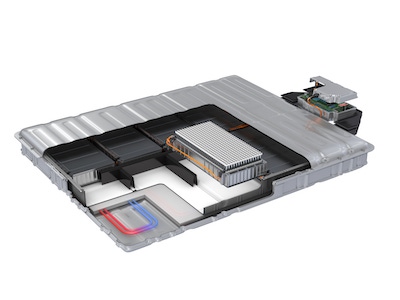UV-transparent PC Resin Offers Solution for Li-ion Batteries
In combination with a UV-curing acrylic adhesive from Henkel, Covestro’s PC compound is used in Li-ion battery cell holders.
March 17, 2020

As automotive electrification continues to evolve, powerful lithium-ion (Li-ion) battery architectures are at the center of discussions around electric vehicles. While battery system designs vary by manufacturer, the joint performance objectives for all automotive battery technologies are longer lifetime, operational safety, cost efficiency and reliability. In their most recent collaboration, Henkel and Covestro developed a solution enabling the efficient fixation of cylindrical Li-ion battery cells inside a plastic cell holder. The solution is based on a UV-curing adhesive from Henkel and a UV-transparent polycarbonate/acrylonitrile-butadiene-styrene (PC/ABS) blend from Covestro.
|
Battery modules with cylindrical cells are constructed with Covestro’s Bayblend© material and efficiently assembled with Henkel’s Loctite adhesive. Image courtesy of Henkel. |
With a strong consumer push to reduce electric vehicle prices, large-scale and cost-efficient Li-ion battery cell assembly is a prerequisite for every automotive OEM. As such, Henkel’s Loctite AA 3963 battery assembly adhesives and Covestro’s UV transparent Bayblend polycarbonate blend were developed for compatibility with high-volume automated dispensing techniques and offer flexible and fast cure mechanisms. The acrylic adhesive was formulated for use with the cell holder, which is constructed of a special flame-retardant plastic. It provides strong adhesion to the substrate material and offers production adaptability through long open times and short cure cycles.
“High-volume manufacturing operations with short cycle times and process flexibility are essential,” explains Frank Kerstan, Head of e-Mobility Europe at Henkel. “The Loctite OEM-approved adhesive designed to secure cylindrical li-ion cells into a carrier is a one-part, cure-on-demand formulation. After high-speed dispensing, the material’s long open time inherently builds adaptability into the process by allowing for any unexpected production interruption. Once all cells are placed into the adhesive and secured in the holder, curing is activated with ultra-violet (UV) light and takes place in less than five seconds.” This is a major advantage over conventional manufacturing where curing times can range from several minutes to hours, thus requiring additional storage capacity for parts.
The cell holders are manufactured from Covestro’s Bayblend FR3040 EV PC/ABS blend. With a thickness of only one millimeter, the plastic is rated UL94 V-0, but shows good permeability for UV radiation in the wavelength range above 380 nanometers.
“The material allows us to construct dimensionally stable parts that are necessary for automated mass assembly,” says Steven Daelemans, Market Development Manager E-Mobility in the Polycarbonates segment at Covestro. “Together with the fast-curing capability of the Loctite adhesives, this material combination delivers an innovative approach to large-scale cylindrical li-ion battery module production.”
About the Author(s)
You May Also Like




